Ben Rivero and his dogs have long subsisted on pagpag to fend off hunger, which has worsened sharply during COVID-19 quarantines.
JUNE 14, 2021
The twelve dogs surrounding Ben Rivero’s home howled with excitement as he approached. Ragged and rail thin, they skittered on short leashes while the old man poured water into their worn, plastic drinking bowls. It was late in the morning and clouds of dust swirled along the highway in Manila’s port area where Ben’s ramshackle house stood. The shambolic patchwork of salvaged wood, tin panels, and plastic sheets shook with every large container truck that rumbled along.
Ben lives here alone with his beloved dogs. Somewhere inside is also a cat or two, darting in and out sight within the darkness of his cramped home, kept from prying eyes by his loyal canines. The 62-year-old junkyard scavenger has kind eyes and a crown of gray, unkempt hair. His longtime partner visits from time to time, but she has chosen to stay somewhere else in this impoverished community of Aroma in Tondo, Manila.
“She can’t stand my smell,” Ben said with a chuckle. “Says I always smelled like a dog.”
Nearby, four garbage bags Ben had collected lay concealed between a pair of wooden carts. A bright orange, oily substance oozed out of them. Ben crouched, loosening the knot on one of the bags to reveal its contents: a moist jumble of half-eaten chicken parts, rice, and plastic utensils. This was the prize. Condemned to the place-out-of-sight, leftovers from nearby restaurans now seduce the desperate, like Ben.
“For me, it is tasty,” he said, carefully sifting through the damp pile of food scraps with his bare hands. He seemed to reflect for a moment, then added, “I like the taste of everything anyway.”
Ben tossed chunks of bone and cartilage into one bucket for the dogs. He saved the chicken parts with a little bit of meat for himself. "For the boss," he said.
To the untrained eye, the parts all look the same.
These leftovers are known as pagpag, which literally means “shake off” in English. It describes how the food is cleaned and prepared to be eaten again.
The cleaning is not as haphazard as it sounds. Ben washed the pagpag he collected in a small cooking pot and left it over a portable gas stove to boil. As it cooked, he put two scoops of kaning lamig, day-old rice, on a plate, and smothered it with cooking oil from a clear plastic bag. It was a habit he picked up when he was a child, when there was nothing else to eat.
Now at least, there was this. After a few more minutes, Ben plucked out a chicken leg from the pot, pale and steaming. This would be one of only two meals for the day. In a tough neighborhood where people learn from an early age to fend for themselves, this is how the old man survives, taking everything a day at a time.
“I’m fine with this. I’m not ashamed,” Ben said. “I’ve got dignity because at least I don’t steal.”

The practice of eating pagpag — discarded food waste from restaurants — crystallizes the desperate hunger for the poorest of the poor.
The practice of eating pagpag is not new, but even here, the pandemic has made an undeniable impact. In the past, junk shop owners offered food scraps to people in exchange for rummaging through piles of garbage to pick out items of value: things like metals, plastics, and cardboard. The exchange was taboo but tolerated, because it put food on the table for everyone.
But as the economic crunch cascaded to the informal sector, many of those junk shops have folded. The ones that remain try to operate under the radar. After all, handling leftovers has become even more dangerous because of the risk of spreading COVID-19.
Nevertheless, pagpag remains available for anyone determined to look.
“We still get some, but in small quantities,” said Rosita Rivera, a longtime resident of Aroma. “Because people still look for it.”
Rosita has been supporting her family for over a decade selling recooked pagpag. It is also how the 69-year old pays for maintenance medicine to control her hypertension and diabetes. Rosita’s clients include blue-collar workers and even local contact tracers looking for something cheap and tasty to eat.
But in the past year, even the quality of food scraps has gone down.
“Sometimes it’s only good for the dogs,” Rosita said. “I think people eating in fast food restaurants must be hungry too, all they leave are the bones.”
2 in 10 or 5.3 million households in the Philippines went hungry in 2020.
Over 6 in 10 or 15.5 million households also said they were food insecure, meaning they didn’t have regular access to food, up 20 percentage points from 2019.
Worsening hunger represents a fight for survival that is quietly spreading alongside the virus. When the pandemic landed on our shores, the government responded with a brutal lockdown. Although the Philippines was not the only country caught flat-footed by the disease, the quarantine, one of the longest in the world, mainly hurt the poor and most vulnerable.
The country experienced record hunger and food insecurity1 in 2020. Based on the 2020 Rapid National Nutrition Survey, 2 in 10 or 5.3 million households went hungry last year. Over 6 in 10 or 15.5 million households also said they were food insecure, meaning they didn’t have regular access to food, up 20 percentage points from 2019.
Things seemed to be getting better at the beginning of 2021, but a recent surge of infections triggered another round of strict quarantine measures in the “NCR Plus bubble” that includes Metro Manila and nearby regions, an area that accounts for one-fourth of the country’s population.
National officials have not yet released the latest data on hunger and food insecurity, but the last time a hard lockdown was imposed in mid-2020, a Social Weather Stations survey showed that a staggering 7.6 million or 1 in 3 households went hungry. Of this number, 2.2 million households reported experiencing “extreme hunger”.
[1] The UN Food and Agriculture Organization (UN FAO) defines hunger as “an uncomfortable or painful physical sensation caused by insufficient consumption of dietary energy,” while food insecurity is “[lacking] regular access to enough safe and nutritious food for normal growth and development and an active and healthy life.”
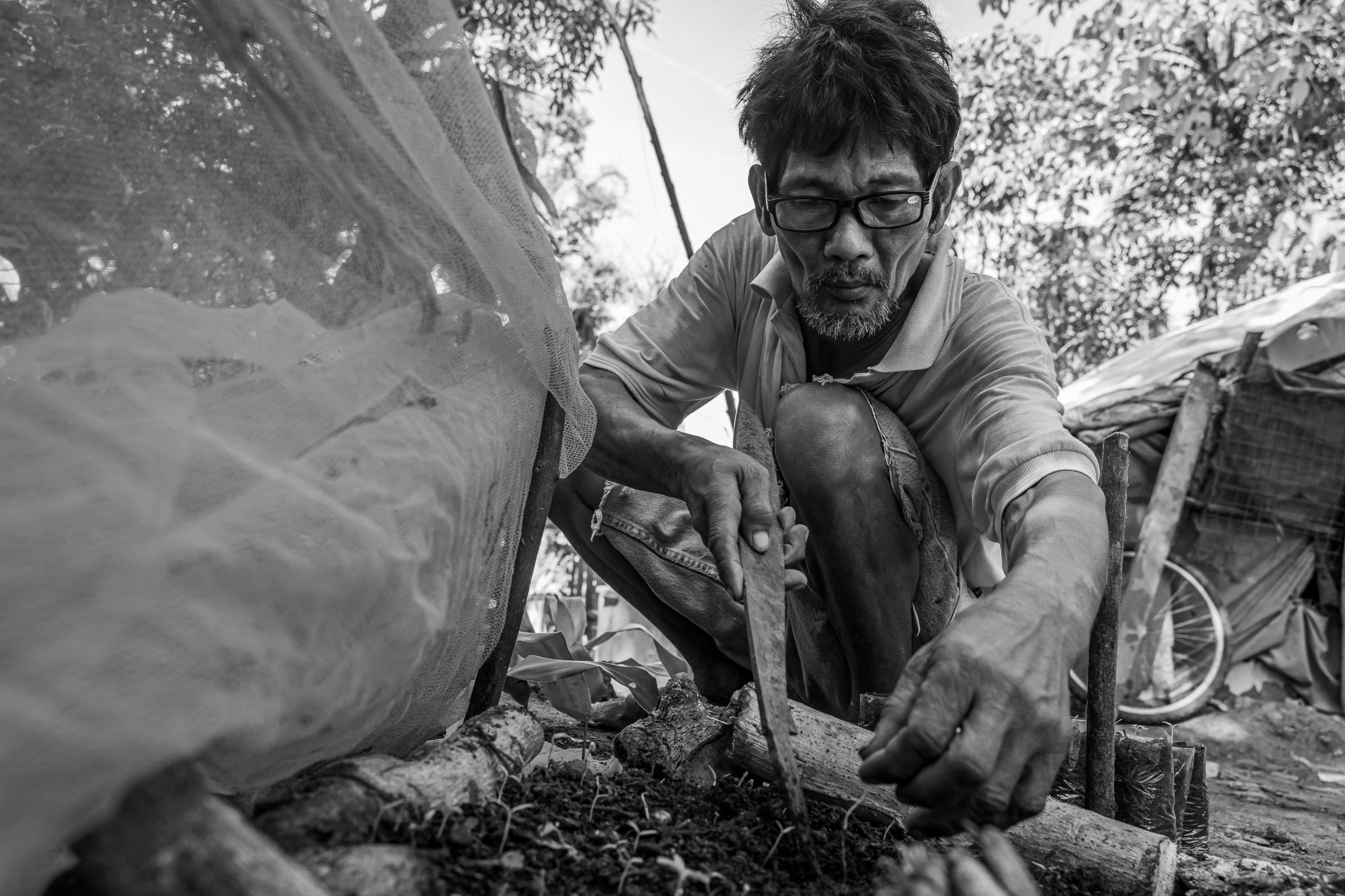
For Benjamin Dela Peña, finding food to feed his family is a daily ordeal.
Eating pagpag has long been symbolic of the kind of extreme poverty prevalent in the nation’s capital. But in the worst of times, even that is an option that not everyone has.
In Pangarap Village, Caloocan, the Dela Peña family makes almost daily hikes to a stream in a grass-covered, hilly stretch of land near their home. The vacant property is owned by a corporation, but security guards allow locals inside to fish and do their laundry.
Benjamin, a slight man with a narrow face and a sparse beard, unfurled a blue mosquito net over the stream, avoiding the parts with holes in them. Smooth stones knotted into corners set around six feet apart served as weights. His two boys helped steady the makeshift fishing net as they dragged it delicately in waist-deep water. The sun was almost directly overhead now, but this was a pleasant strip of land with a wide view, the tall grass along the banks stirring gently in the breeze. Every once in a while, Benjamin would raise the net to examine their catch.
It wasn’t much. Today’s haul: around two dozen guppies, each only larger than a fingernail, and an equally tiny freshwater shrimp.
“Sometimes we’d be able to catch around half a kilo of fish here,” Benjamin’s wife, Jocelyn, said with a hint of embarrassment. “ I guess a lot of people came ahead of us today.”
Hungry, the Dela Peñas started walking home. This community is still within the National Capital Region (NCR), but the atmosphere is bucolic. There is decent vegetation, the roads are unpaved, and the crowing of roosters punctuate the early morning. Most homes do not have electricity, or running water.
The couple and their 12 children live in a shapeless house, like a giant log draped with tarpaulin. Near the entrance where the daylight streaked, Jocelyn prepared lunch for the family. She crushed three cloves of garlic with the flat of her knife, chopped it up with half a small onion and poured a drop of cooking oil in a pan, squinting as a thick, gray smoke rose from the firewood. It took no time at all for the guppies to cook. She set the meal on a wooden table outdoors with a potful of rice, a pack of soy sauce, some plates and spoons. This meal required no forks.
Each one measured a portion of the food thoughtfully. Jocelyn’s mother-in-law was here too, giving the couple a total of 13 mouths to feed. Benjamin waited for everyone to eat, before scraping what was left in the bowl, mixing the slurry with his rice.
in April 2021, equivalent to 8.7 percent. Annual unemployment reached a record-high 4.5 million or 10.3 percent last year, hitting a peak of 17.6 percent or 7.2 million Filipinos in April 2020.
in April 2021, equivalent to 17.2%, representing those working but are looking for more work or longer working hours.
Life has always been tough for the Dela Peña family, who moved to Manila from the provinces 30 years ago, but the pandemic has plunged them further into crisis. Nowadays, Benjamin, a laborer, would only find work four to six days a month.
To put food on the table, he’s taken to planting vegetables in their yard instead. Right after eating, he tended to rows of newly sprouted eggplants, their green tendrils barely poking out of the earth. Alas, at this scale, backyard farming is not enough to meet the family’s daily needs. It would take another four months before they can expect a modest harvest.
“This is what keeps us busy when we’re at home, planting, at least it’s free, but that would take a while,” Joceyln said, her sunken cheeks telling the story without words. “During tough times we just make rice porridge if we can manage. Sometimes we don’t eat for a day and a half. We would sleep without eating anything.”
In their most miserable times, Jocelyn spins little tales to soothe the worries of her children.
“I can’t take it when they say, ‘Ma, I’m hungry.’ If I could only find a way, I would give them something to eat, but there’s really nothing here. So I would just say, ‘Don’t worry, maybe we’ll get some money later, just wait a little more, someone will sell food by the street, tomorrow we’ll buy some food. Maybe tomorrow we’ll have money.’”
It’s a big maybe. Work opportunities for the poor have been stifled because of a mixed bag of restrictions continue to be imposed in different parts of the country more than a year after a state of emergency was declared, . The impact of the on-again, off-again shutdowns on the economy has been severe. Annual Gross Domestic Product (GDP) plummeted to -9.6 percent in 2020, the lowest on record and one of the worst economic performances in Asia.
Yet despite the enormous price tag, the virus continues to spread, overwhelming the health care system of the country. In downgrading its growth projection for the Philippines in 2021, World Bank chief economist for East Asia and Pacific Aaditya Mattoo made a stinging observation, saying the country’s tough response “has imposed a big cost on the economy without delivering a commensurate benefit in terms of containment of the disease.”
Ultimately, the economic downturn has left many Filipinos unemployed and looking for more work. According to the Philippine Statistics Authority (PSA), 4.14 million Filipinos were jobless in April 2021, as the government imposed harsher quarantine restrictions as COVID-19 cases surged. Meanwhile, underemployment, or those working but are looking for more work or longer working hours, reached 7.45 million. The annual unemployment reached a record-high 4.5 million or 10.3 percent last year, hitting a peak of 17.6 percent or 7.2 million Filipinos in April 2020.
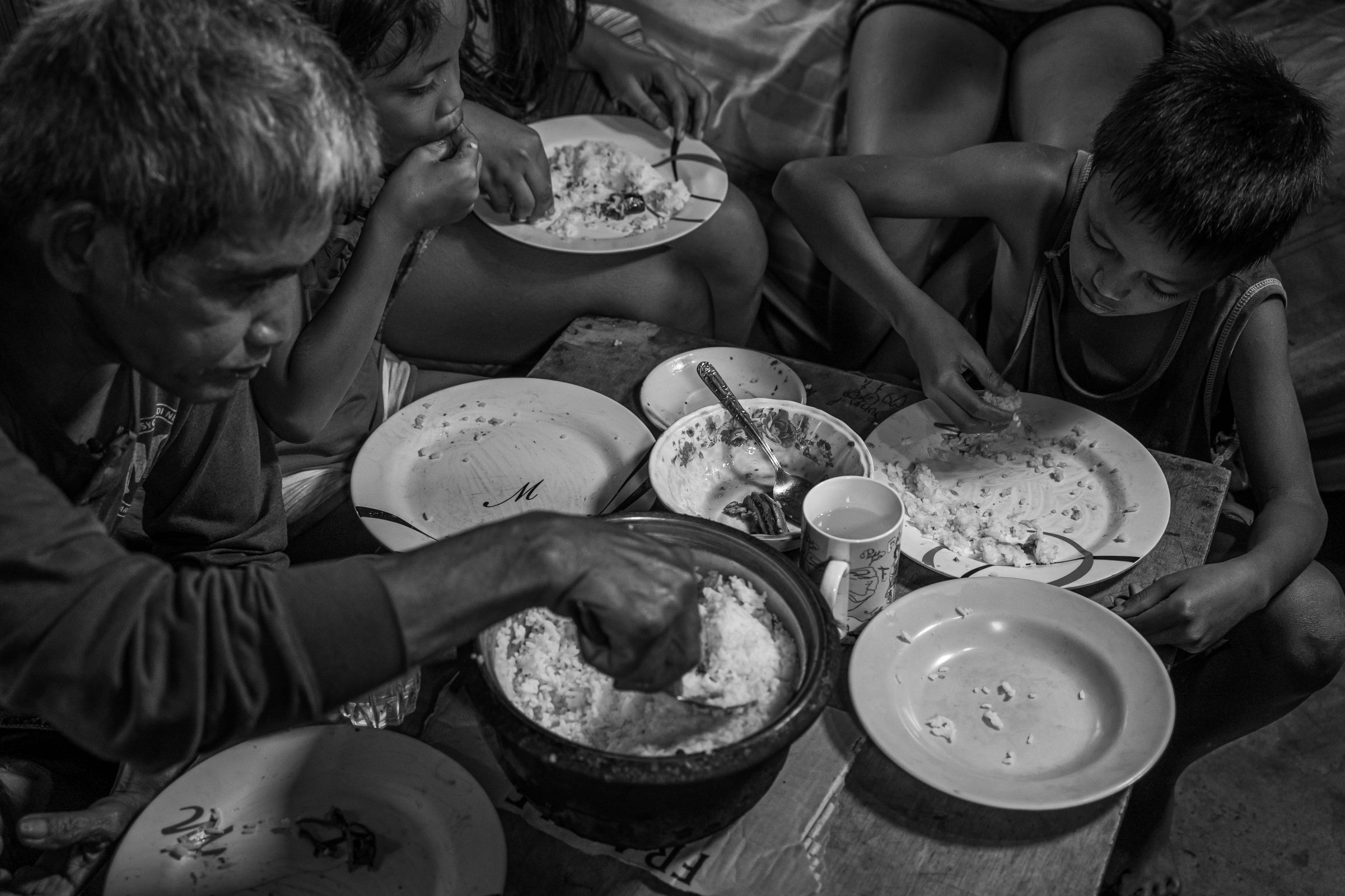
Based on data from the Asian Development Bank (ADB), across Southeast Asia, the Philippines has one of the lowest health and income support spending as a percentage of GDP during the pandemic crisis.
It was in the midst of the pandemic when Imee Satuito, mother of seven, lost her job at a shuttered nightclub in Quezon City. Her husband, a construction worker, also fell into unemployment. They tried scavenging for a while, but the competition was stiff. Many were also out of work, and there were only so many glass bottles, plastics, and paper one can find in the garbage each day.
Imee ended up begging in the streets.
On a piece of insulation, she scribbled her appeal for loose change in big, bold letters. A little smiling face was drawn in one corner, a presentation of cheerfulness she couldn’t bear make herself, not now, not even beneath the mask she was always wearing. Being here was a demoralizing experience.
“I was ashamed. It’s like I’ve gotten so low,” Imee said, her voice cracking. “But I’m used to it now. I can’t do anything about it anyway.”
They have always struggled, but Imee said they never experienced hunger like this before. On special occasions, she would even treat her family to a whole piece of store bought roasted chicken. Sometimes, there would even be Jollibee, she says. Her face lightened up a little as she said this, but became troubled again presently. These days, all that mattered was earning enough to buy milk for her two youngest children after each day on the street.
“Not everyone would give us change. Others do, but it would come with a lecture. Why don’t I find a job, they say, I look able-bodied anyway,” Imee said.
It was already dark when Imee got home. The neighbor’s dog barked loudly. She was immediately greeted by her 9-year old daughter, Irene, who took the packs of powdered milk from her mother. Irene tore one open with her teeth, emptied its contents into two transparent baby bottles, and poured hot water into the formula, screwing the caps on and swirling them one after the other with her right hand. Finally, she filled the bottles to the brim with colder water, making the temperature right before replacing the caps and handing it over to her siblings. She has done this many times before.
Imee prepared some fish for dinner. It’s the fourth birthday of her second youngest son, Almee, who had just woken up from a nap and stumbled to the dinner table. Her mother whispers to the child gently as she feeds him with a spoon. There was going to be no celebration today. The whole family eats in silence.
Sonny Africa, economist and executive director of Ibon Foundation, blames the “failed” COVID-19 response for causing widespread hunger in the first place.
“The excessively harsh lockdown and loss of livelihood of millions upon millions of Filipinos, that’s what caused hunger. Enough food is available, the problem is money,” Africa said.
President Rodrigo Duterte has repeatedly bristled at any criticism of his government's pandemic response. “We never fell short in our aid,” he said in a recent television address. “We spent billions.”
In April 2020, government released PHP99.2 billion (USD2.07 billion) of cash aid for 17.6 million families under the Bayanihan to Heal As One Act (Bayanihan 1). Six months later, another PHP84.4 billion (USD1.85 billion) for 14.1 million families was approved under the subsequent Bayanihan to Recover As One Act (Bayanihan 2). The administration initially rejected additional cash assistance, but harder quarantine measures this March obliged them to approve an additional PHP1,000 (USD20.90) per individual through a supplemental Social Amelioration Program (SAP).
Delays have hampered the distribution of the funds, but if a family received the maximum amount under Bayanihan 1, Bayanihan 2, and the supplemental SAP, they would have gotten PHP15,607 (USD325.55). Based on the official nationwide poverty threshold of PHP10,481 (USD218.63) per month, that translates to relief for only a month a half. Never mind observations that the threshold, which translates to around PHP79 (USD1.65) per individual per day, is too low to begin with.
Based on data from the Asian Development Bank (ADB), across Southeast Asia, the Philippines has one of the lowest health and income support spending as a percentage of GDP during the pandemic crisis.
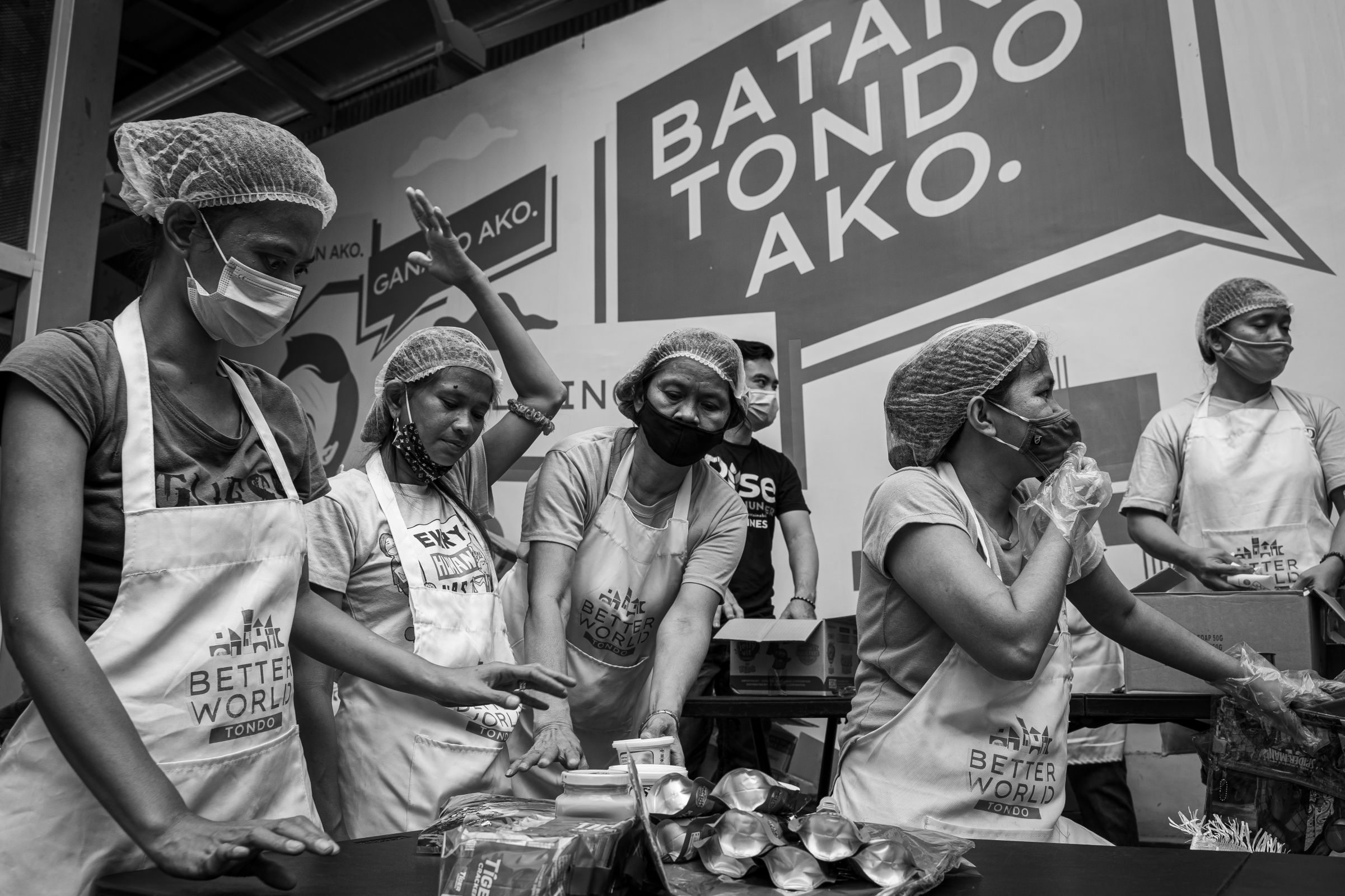
Rise Against Hunger operates a food bank in Tondo, Manila.
Jomar Fleras has seen the problem of hunger grow worse since the start of the pandemic. He serves as the Executive Director of Rise Against Hunger, an international non-government organization that operates the first and only food bank in the Philippines.
We meet during their regular distribution of relief goods at one of their depots in Tondo, Manila. Volunteers were handing out bags containing instant coffee, fresh milk, flour, nutribun (a calorie dense bread), cheese spread, and a small tub of margarine. There were even some personal care products and school supplies thrown in there, much to the delight of mothers who waited in line.
“Each week they would get something different, depending on the donations we get,” Jomar explained.
Food banks operate on a simple premise: hunger can be addressed by drastically reducing the amount of food that goes to waste. Rise Against Hunger formed partnerships with restaurants and local manufacturers to collect food surplus that would otherwise end up in bins.
According to UN FAO, an estimated 30 percent of the world’s food doesn’t end up on our tables. The reasons are diverse. In richer countries, greater food loss occurs in processing, retail, and consumption. This is blamed on the over purchase and preparation of food, as well as poor food planning in general.
Meanwhile, in low to middle income countries like the Philippines, most loss occurs in the production, handling, and storage of food. Farms will often discard food items that have cosmetic imperfections, as they are less desirable in the market. Lack of transportation and storage infrastructure, overproduction, or a sudden drop in demand can also lead to a practice known as dumping.
At the height of the Luzon-wide lockdown last year for example, some vegetable farmers in the Cordillera region made the painful decision to throw away their crops or leave them unharvested because they could not bring them to market.
UN FAO says that the generated waste is more than enough to feed the estimated 690 million hungry people globally.
As poor families lost income and struggled to put food on the table during the pandemic, food manufactures dealt with a problem on the other side of the spectrum: raw materials and products were going to waste because of the sudden shutdown. Jomar says donations to their food bank quadrupled in 2020.
“They suddenly had excess supply. So to avoid waste, they just donated it. At the same time, they also wanted to help because so many people were struggling,” Jomar said.
Rise Against Hunger’s list of partners has been steadily growing since opening their first food bank in 2015. Last year, Jomar said they were able to gather 200 million pesos worth of food and cash donations for 1.5 million individuals in communities all over the country.
It wasn’t always this way. Many companies were initially reluctant to work with the organization, fearing their products might be misused or resold. Rise Against Hunger had to win the trust of its donors.
“In their framework, when it comes to surplus food, they just throw it away. What we want is to be included in their value chain,” Jomar said.
Distributing relief goods during crisis isn’t new, but the merit of food banks is two-fold: reducing food waste and bringing surplus products to the most needy. With a steady supply of donations, it also promises to be sustainable. Rise Against Hunger focuses on communities to make a meaningful impact on the health and wellbeing of their beneficiaries over time.
Yet despite the growing potential of food banks, Jomar recognizes that it should only be part of a bigger strategy to address hunger, especially in these uncertain times.
“We are just part of a very complex solution to hunger and poverty,” he said. “We know exactly where our limits are, we’re just a band-aid solution. When you’re hungry, we can address that now. But in the end, the government still has to do its function of boosting the economy, getting people to work, creating livelihood programs. Eventually we want people to graduate from being a food bank member to being on their own.”
Indeed, even as a stop gap measure, food banking has a major limitation in that it works best in urban areas with high population densities. Aside from the concentration of major food businesses there, food banks can serve more people in the city. In the countryside, populations are dispersed, making them hard to reach.
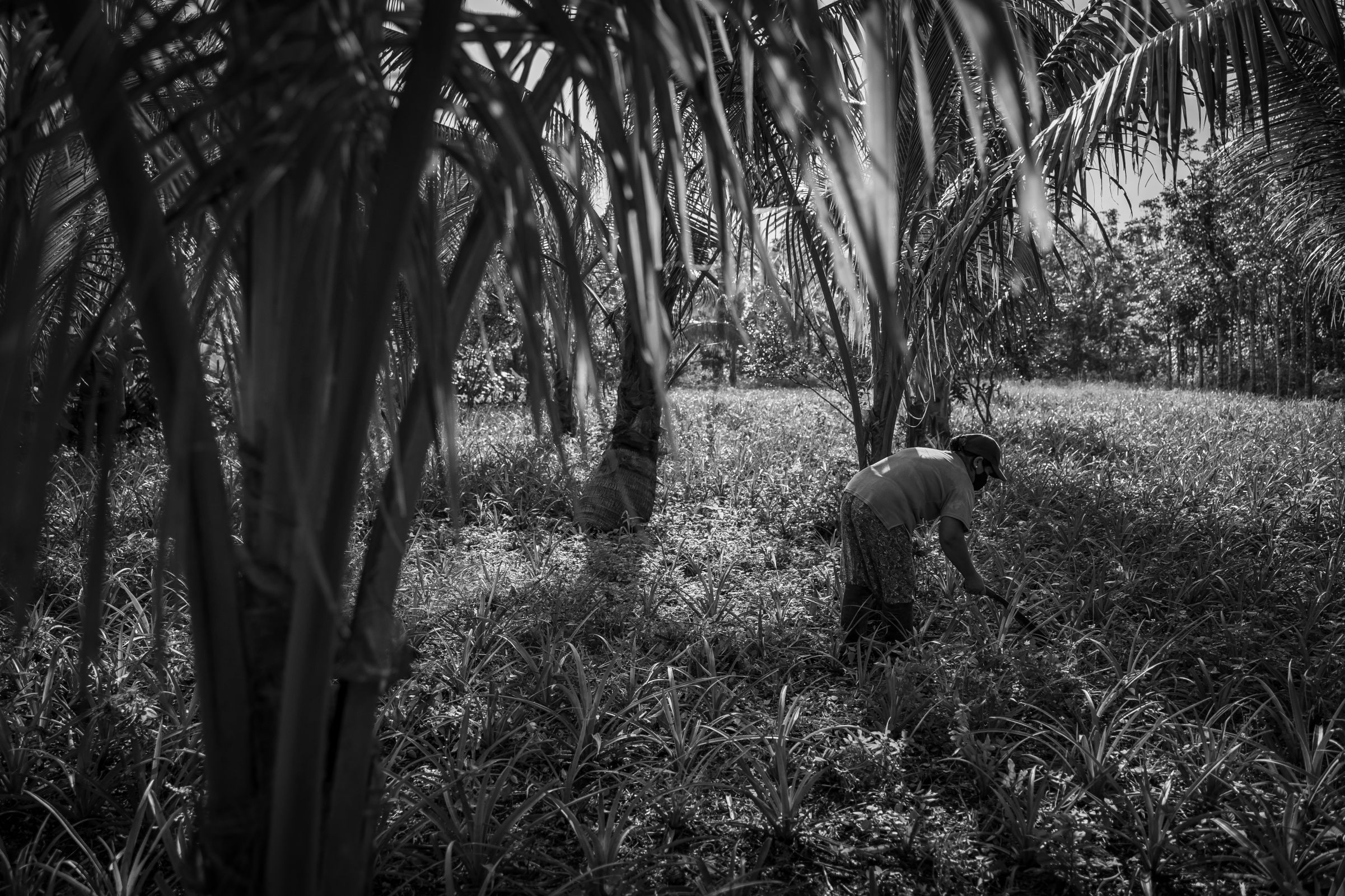
Erlinda De Jesus, a pineapple grower in Camarines Norte, saw her crop go to waste last year because of transport issues due to quarantine restrictions.
Ironically, the people who produce most of the food in the country are the ones who need safety nets the most. Hunger is worse in underdeveloped agrarian communities, where opportunities to earn are more scarce. Data from the PSA shows that poverty incidence in rural areas is 24.5 percent, compared to 9.3 percent in urban areas. Farmers and fisherfolk are also more susceptible to extreme weather events and the impacts of climate change on their livelihood.
Erlinda and Miguel De Jesus are pineapple growers from San Vicente, Camarines Norte. Like many farmers in the Philippines, they work on land they don’t own, splitting their harvest 50-50 with their landlord. The family is not rich, but through sheer hard work, they were able to acquire some of the trappings of a modest rural life. Their house has cement walls and a sari-sari store out front. They had a television in one corner, where the family would watch afternoon dramas together when it was still too hot to go to the fields. The floor of a small common area is finished with smooth, cream colored tiles, although some were visibly cracked.
“They were selling them at a discount in the hardware store because they were damaged,” Erlinda explained. The 50 year-old farmer had a round face, a wide nose and calloused hands. “We’ve always wanted tile flooring, it looks nice,” she added, shyly.
Pineapples are not fussy plants. Out here, they grow the Queen or Formosa, the sweetest variety of this tropical fruit. It makes sense to cultivate the robust and adaptable plant in a province regularly struck by tropical cyclones that seem to get stronger and more unpredictable each year.
Pineapples, however, take a relatively long time to bear fruit. Erlinda and Miguel have to wait a year and half before they can harvest their crop. In the meantime, they take on jobs in others farms to scrape by, hard manual labor that earns them less than minimum wage.
During their last harvest in 2018, Erlinda said they earned PHP10,000 after paying off their loans, the fruit of 18 months of patience and perseverance. But 2020 was not as kind. As COVID-19 restrictions took effect, trucks stopped hauling products from small pineapple farms. The couple wasn’t able to sell a single crop. A year and a half of work, ruined.
“Our products couldn’t get out. They all rotted on the ground,” Erlinda said. “Some we just gave away to those who wanted it, just so it doesn’t got to waste.”
The family has fallen on hard times since. Their small store went belly up with dwindling customers and no money left to sustain it. With each passing month, Erlinda watched the shelves go empty as they slowly consumed the packs of noodles and canned goods themselves.
On some afternoons, Erlinda would harvest pako or fiddlehead greens, the furled fronds of young fern. In the cool shade of a nearby river bank, the plants still grow wild, green, and plentiful. At home, she would toss these with some onions, tomatoes, vinegar, and a dash of brown sugar to make a salad for the family. It’s a dish one might find in a fancy restaurant, but it remains a humble source of sustenance here.
“The hunger here is unbearable,” Erlinda said. “We’re just lucky we can get some vegetables here and there, it’s free. If it weren’t for that, I don’t know what will happen.”
With a fresh loan, Erlinda and her husband have tried planting pineapples again. She stopped working for a moment, her hand clutching a sickle, and looked appraisingly at their patch of land. The long rows of crop were still young, their pointy leaves growing low to the ground. In 10 months, they would know if this new gamble has paid off.
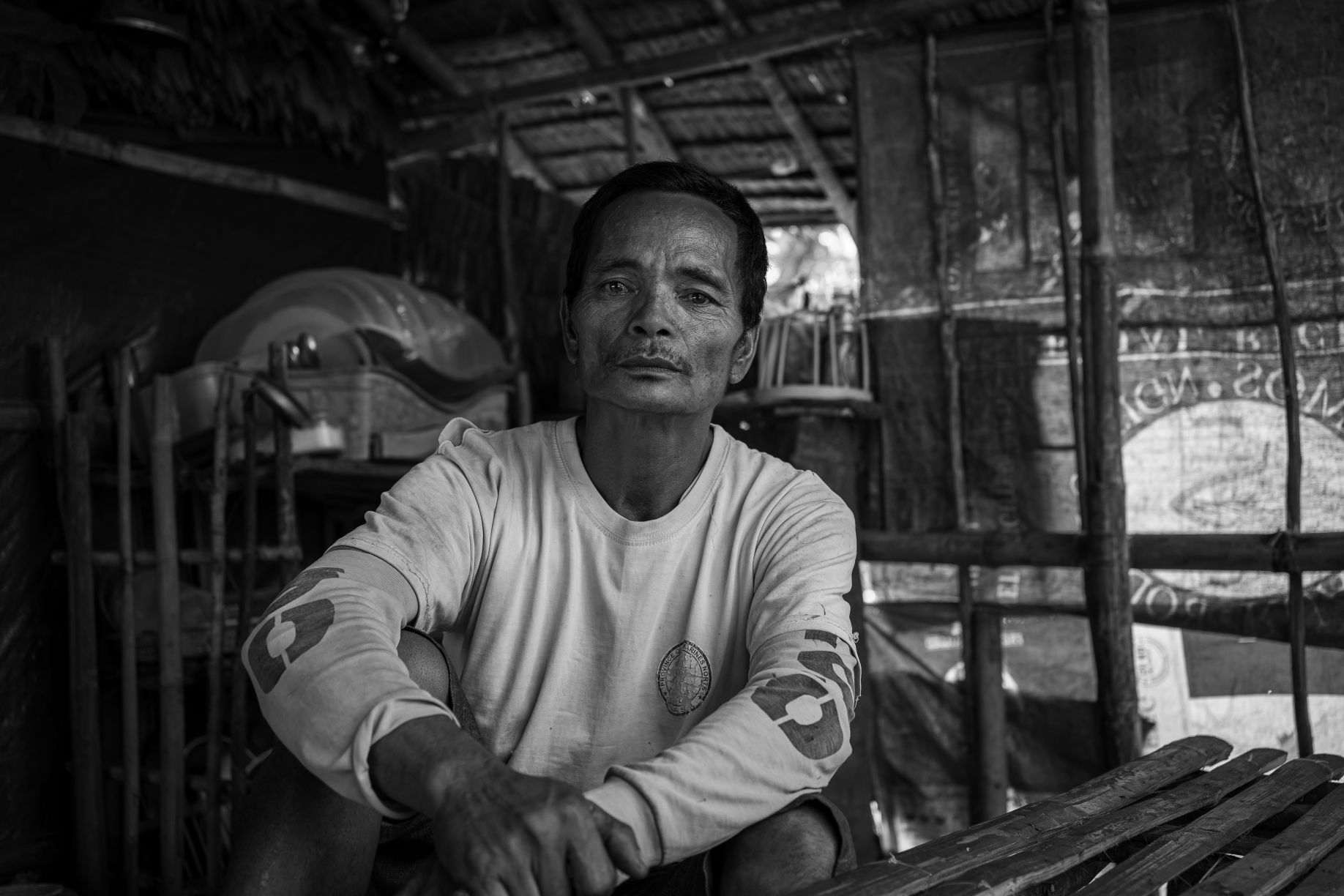
Jovito Mañago, a fisherman in Mercedes, Camarines Norte.
In the neighboring town of Mercedes, things are no better in the fishing village of Quinapaguian. There is no farming on the tiny island, so its population of less than a thousand relies on the bounty of the sea.
Jovito Mañago lowered his fishing line carefully, pinching it between the thumb and forefinger of his right hand, as his boat pitched and rolled on the water. The father of nine had short black hair under a threadbare knitted cap, prominent cheekbones, and deep wrinkles in the corners of his doleful, brown eyes. He waited. Handlining was not for the impatient.
Feeling the line quiver between his fingers, Jovito yanked it. He immediately shook his head and tsked loudly. He knew there was no fish at the other end of the line. Bringing the hook to the surface, he replaced the bait and tried again. Minutes passed. Sparse clouds moved overhead as a steady breeze blew from the east. Still nothing. He scanned the surface of the water, his eyes looking as worried as ever. He tried once more. This time, his hook caught on piece of coral underwater and snapped right off.
“There really is no fish left here, they’re all small,” Jovito muttered.
Because of lax regulation and a dearth of opportunities for coastal communities, municipal waters like this have deteriorated from decades of unsustainable and destructive fishing practices. Fish stocks have dwindled. And yet, fishermen like Jovito have no choice but to push their luck, if only for subsistence. After several attempts, he finally caught a striped fish no bigger than the palm of his hand. Jovito could barely manage a smile.
Having depleted his hooks after two hours of fishing, Jovito headed home, three small fish in his bucket. It will be boiled with a mountain of malunggay leaves and sliced upo, to be shared by the whole family.
Twice a week, Jovito joins a larger fishing crew that ventures farther out into sea on multi-day expeditions. Out there, they are able to catch larger pelagic fish, which they can sell in the market. On a good week, he earns around three hundred pesos as a crew member. But the odds of success aren’t guaranteed. Larger, industrial fleets tend to crowd out smaller fishing boats, and Jovito says it gets harder and harder to make these trips profitable. Sometimes when there’s no catch, Jovito says they end up eating their supply of bait instead.
“It is really tough to make ends meet,” Jovito said in his soft voice. “Sometimes I just drink water when I see my kids don’t have enough to eat.”
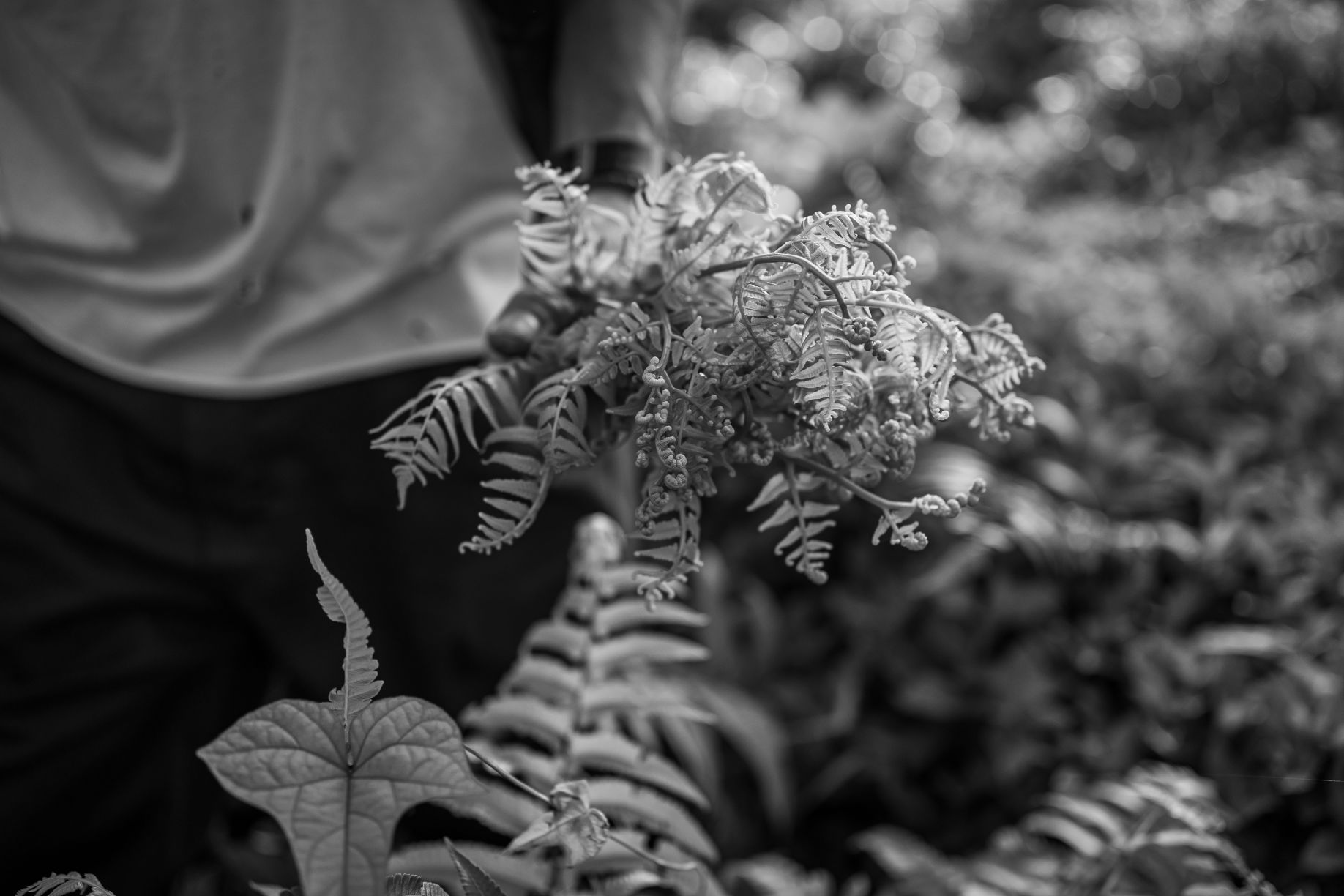
Farmers in Camarines Norte have taken to harvesting pako — fiddlehead greens — for food.
It is an age-old paradox: people in the countryside, who feed the rest of the population, struggle to feed themselves. It is a problem that precedes the pandemic, and points to a much deeper affliction in the Philippine agricultural sector.
Cherrie Atilano is the founder of AGREA, a social enterprise focused on promoting fair and sustainable agribusiness in the country. Their work currently focuses on Marinduque, where they aim to establish a “One Island Economy”, a form of economic development “with sensitivity to the environment and concern for social well being”, according to AGREA’s website. Cherrie believes that a long-term solution to hunger begins with modernizing agriculture, uplifting the livelihood of farmers and addressing food security in the process.
“It’s such a crime against humanity that the producers in the food chain are the poorest and hungriest. Aren’t they supposed to be better off?” Cherrie said. “I think all of us should ask that question, if the people putting food on our tables also have food on their table.”
Cherrie, who hails from Silay City, Negros Occidental, has made it her mission to transform the agricultural sector. Her work has been recognized both locally and overseas. The Department of Agriculture (DA) even named her as its Food Security Ambassador in 2020. Her partnerships with the government notwithstanding, Cherrie spoke frankly about what she feels is the lack of support for Filipino farmers and fisherfolk.
At PHP71 billion pesos, the DA’s budget for 2021 makes up only 1.6 percent of the national budget. In terms of percentage, it hardly grew from the previous year. Meanwhile, the allocations for other agriculture-related offices such as the Department of Agrarian Reform and National Irrigation Authority have also fallen.
“The math is so wrong. We should increase our budget for agriculture, because how can you help if your budget is so tiny, and you’re feeding 110 million Filipinos? That’s why so many people are hungry, poor, and malnourished in our country,” Cherrie said.
Timely intervention can make a world of difference in the lives of smallholder farmers who often take on debt in the hope of repaying it during harvest. Pineapple farmers in Taytay also faced the prospect of losing their entire crop last year during the hard lockdown. Desperate, one of these farmers, Sonny Reyes, reached out to Cherrie on Facebook, asking for assistance in transporting 15,000 pineapples to Metro Manila. Cherrie scrambled to hire a truck, and helped the farmer navigate some 13 checkpoints from Rizal to Makati City, where the produce finally ended up. Using the power of social media, Cherrie sold all of the pineapples in days. Sonny was able to settle his loan, pay the tuition of his daughter, and most importantly, put food on their table.
It’s the kind of support farmers hope to see from the government, Cherrie said. The agricultural sector has been languishing for decades, lagging behind our neighbors in the ASEAN region. Although the agricultural sector employs approximately 30 percent of the labor force, it only accounts for around 9 percent of the GDP, suggesting a low productivity.
The problem is well-known and studied. A 2018 paper from the Philippine Council for Agriculture, Aquatic and Natural Resources Research and Development (PCAARD) cites a myriad of longstanding issues that hamper productivity. These include limited access to credit and finance, low farm mechanization, inadequate post-harvest facilities, inadequate irrigation, scant support of research and development, and, crucially, incomplete agrarian reform implementation.
According to peasant group Kilusang Mambubukid ng Pilipinas (KMP), an estimated 70 percent of farmers still work on land they don’t own. Often, agrarian reform beneficiaries end up leasing or even selling their property back to their landlord, a practice prohibited by law, because of the lack of capital and support services to make their land productive.
“These smallholder farmers that have no access to capital, no access to market, no access to training, no access to farm inputs, they really have a hard time. They end up leasing their land, but the rent for land is so cheap. Or they will just sell it. They might be able to build a small house, or buy a tricycle, but that’s it. They’re poor again” Cherrie explained.
Modernizing agriculture will improve the livelihood of farmers and fisherfolk, lifting them out of poverty. It will also help make basic food items more affordable. According to the PSA, the average Filipino family spends nearly half of its resources per month on food: 41.5 percent of total household expenditure. In comparison, families in Western countries like the United States and the United Kingdom, only allocate around 10 percent of their monthly budget on food.
Poor Filipino families allocate an even a bigger portion of their budget on food. The inflation-adjusted official food threshold, which is the minimum income required to meet basic food needs, is currently PHP2,133 (USD44.58) per week for a family of five in NCR. The minimum wage in the same region is PHP537 (11.22 USD) per day or around PHP2,686 (56.13 USD) for a five-day work week. This means a single-income household would need to allocate around 79% of their budget just to meet their basic food needs.
To make matters worse, food prices have been climbing steadily since late last year. The inflation rate stood at 4.5 percent last March, only dipping slightly after five straight months of acceleration. This puts additional pressure on Filipinos who have already seen their incomes plummet because of the economic downturn, driving hunger and food insecurity.
For Cherrie, pandemic or not, it is a situation that should not happen, given the rich resources of the Philippines.
“We have a lot of water, we have the best sunshine, our soil is fertile. If you think about it, there shouldn’t be any Filipinos that go hungry,” Cherrie said.
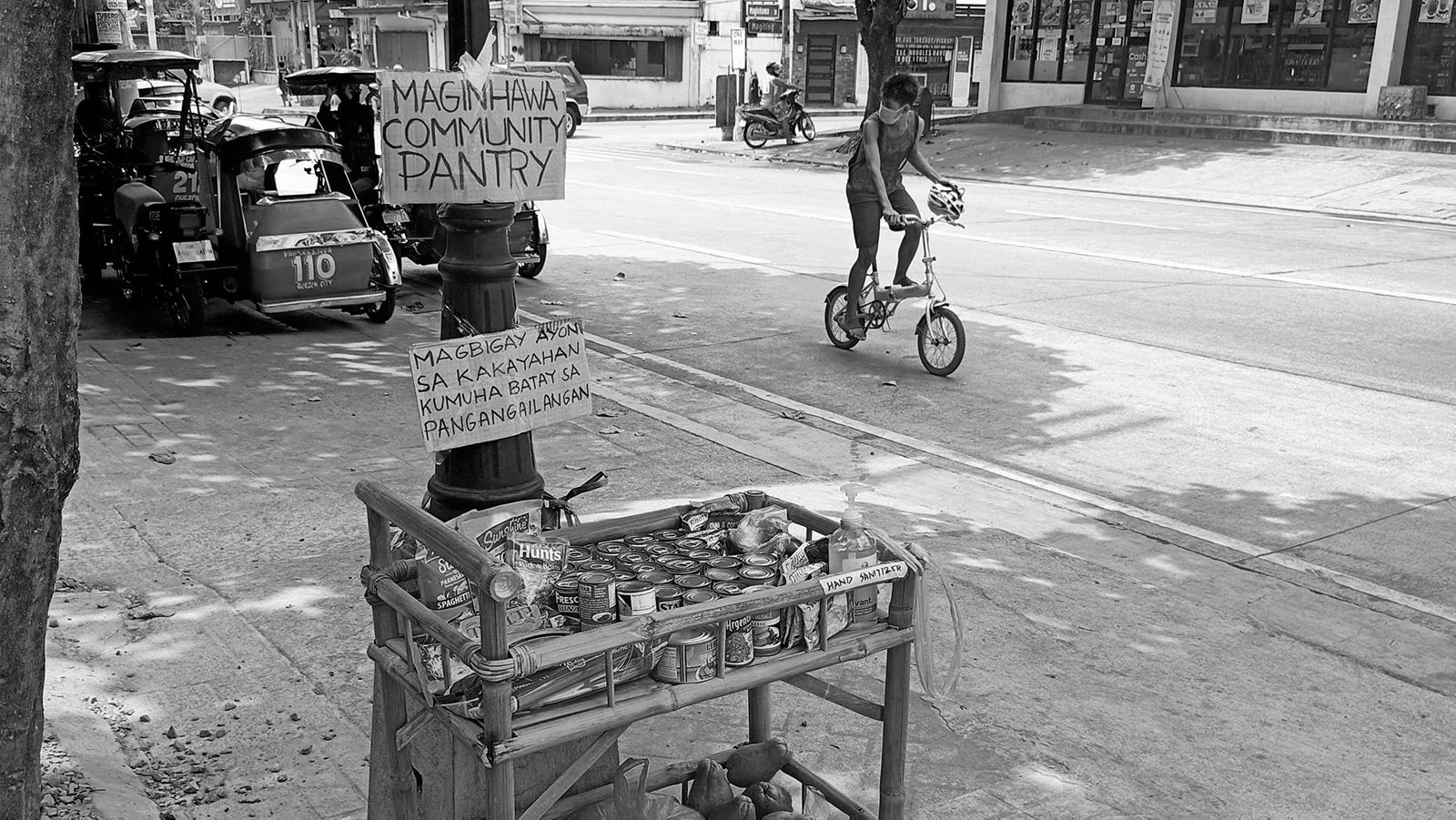
The Maginhawa Community Pantry started with a cart and a sign. Photo: Anna Patricia Non
As it turns out, it wasn’t government dole-outs or corporate social responsibility programs that captured the imagination of people at a time of widespread need. In past weeks, a spontaneous movement has sprung up all over the country, inspired by the actions of an unassuming woman.
Moved by the mounting hardship of others, Ana Patricia Non, a 26-year old furniture business owner who goes by the nickname “Patreng,” set up a modest bamboo cart along Maginhawa Street in Quezon City and filled it with free vegetables and other basic groceries. Above the cart, a handwritten sign on a piece of cardboard read, Magbigay ayon sa kakayahan, kumuha batay sa pangangailangan — Give what you can, take what you need.
The concept, though not necessarily original, was captivating in its simplicity. People drop off goods they can spare and those who need it can get them for free. It was a system of trust that became an act of defiance against the helplessness and anguish of the pandemic, a community effort that did not rely on government bureaucracy or the goodwill of big businesses.
“The unemployment rate is high, the line for relief goods is long, and Pinoys are hungry,” Patreng said in an interview with GMA News Online. “We have been demanding a lot, but supplies are not enough. We really need to help each other. Community effort.”
When word got around, initially fueled by social media and eventually through traditional media coverage, throngs of people made a beeline to the community pantry. They came from different walks of life but share similar circumstances: a single mother of five who lost her job, a construction worker who had to sell his bicycle for food, a former teacher taking care of a brother undergoing dialysis. At times, the queue stretched over a kilometer long.
The simple gesture also inspired many. Donors and volunteers multiplied. Some just showed up to Patreng’s cart, rolled up their sleeves, and started to work. Tricycle drivers repacked donated rice. Fishermen from Rizal sent kilos of tilapia. A taho (silk tofu) vendor in Kawit, Cavite offered his merchandise for free. Others set up their own community pantries. In a matter of days, hundreds emerged all over the country. Even a 9-year old boy, the son of Mangyan farmers, in Sta. Cruz, Occidental Mindoro donated half a sack of sweet potatoes to their community pantry.
It wasn’t long before the community pantries attracted the attention of authorities.
Patreng said police showed up at their pantry and attempted to get her personal details from volunteers, such as her number, address, and relationship status. Then, the local police office and the National Task Force to End Local Communist Armed Conflict (NTF-ELCAC) shared posts made by others on social media linking community pantries to communist rebels.
The police later deleted their post and apologized after facing public backlash and rebuke from no less than the City Mayor. But NTF-ELCAC spokesperson Lt. General Antonio Parlade doubled down. In a bewildering interview with local cable news network One News, he continued to question the motives of pantry organizers.
He then compared the entire operation to the work of the devil. “Satan gave Eve an apple. That's how it all started,” Parlade said.
Other public officials came to the defense of Patricia, including some senators and even the Secretary of National Defense. But the big boss himself took a swipe at community pantries, criticizing so-called health protocol violations. In one of his late night public addresses, President Rodrigo Duterte called the organizers insincere and ignorant. “Fools. Those idiots don’t think. They just want to show to the people that they care but they don’t really care because of their ignorance,” Duterte said.
The threats and harassment continue. Some pantry organizers said they have chosen to suspend operations because of concerns for their safety. In a Facebook post, Patreng revealed that she received death and rape threats. The media attention was also taking its toll.
“I couldn’t go out yesterday because I don’t have a car, much less security. I don’t know if it’s worth going out for photo ops if my safety is at stake,” Patreng wrote.
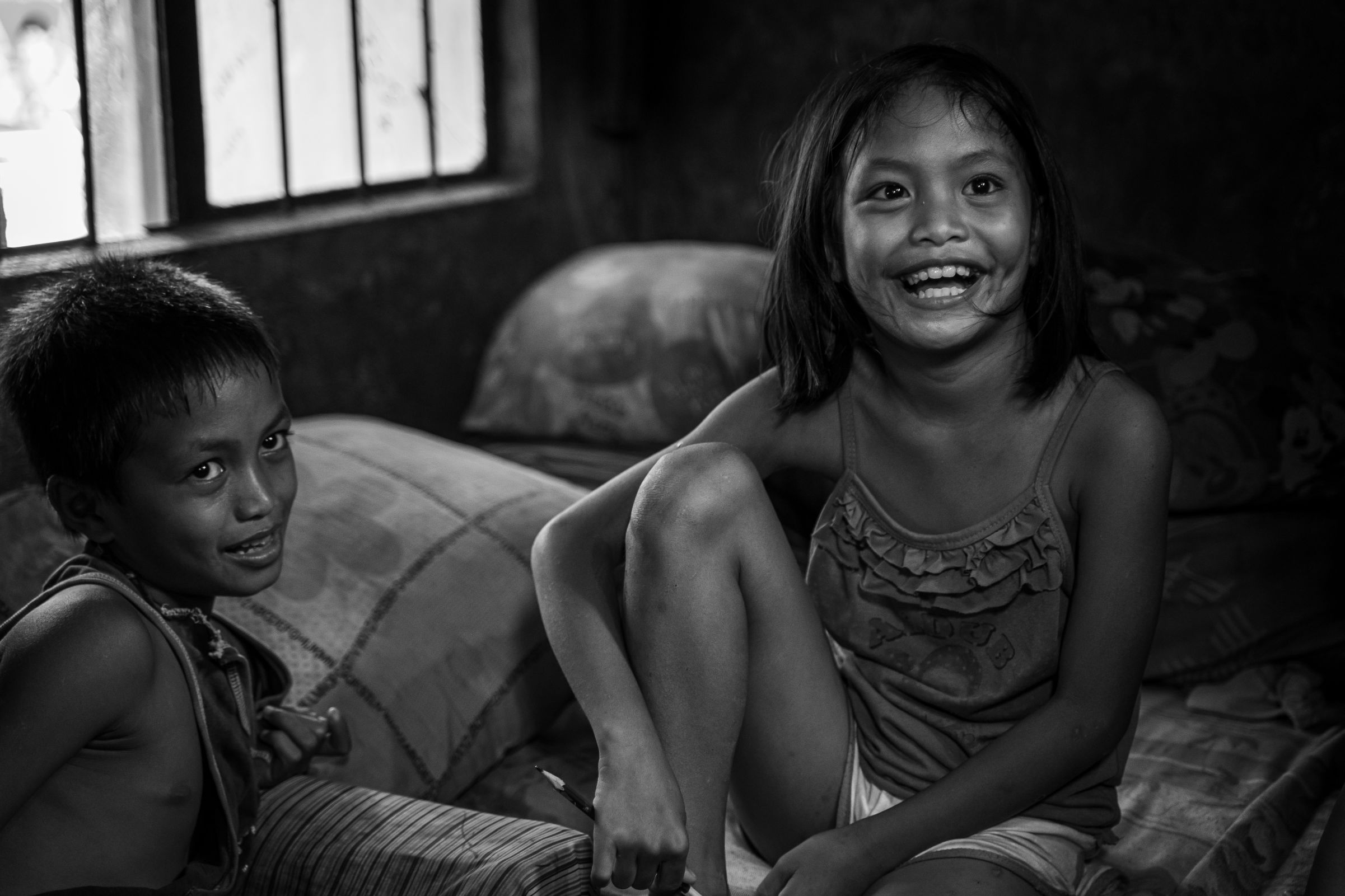
Hunger and chronic undernutrition is a huge problem facing children in the country.
When it comes to hunger, the stakes could not be higher. Addressing the problem is not just a moral obligation, an act of philanthropy to ease the burden of the poor; it is society’s investment in human capital, or perhaps more fittingly, a kind of preparation against future disaster, like a wise man building his house on rock.
Malnutrition remains a huge problem in the country. Stunting, a condition where children aged 0 to 59 months are small for their age because of prolonged undernutrition, affects 1 in 3 children nationwide, and almost half of children from poor families.
Back in Mercedes town, nutritionist Lorna Pamor, went around Quinapaguian Island with village officials on a hot morning, measuring the height and weight of children there. The toddlers, wide-eyed, gripping their mothers tightly, were remarkably well-behaved, following instructions dutifully and showing great courage in slipping into a harness that secured them on a hanging scale.
Lorna sighed heavily as she looked at her records. Far too many of the kids were filed under the red column, either stunted or underweight. The gains from nutritional programs of previous years, seemingly wiped out because of the pandemic.
“It’s a little sad,” Lorna said. “This is really a poor island barangay with seasonal livelihood, sometimes there’s really nothing to eat. They need more support.”
Stunted children are four times more likely to die than children who are not, a statistic made even more glaring in a raging public health crisis. Based on estimates from the National Nutrition Council (NNC), an astonishing 95 children die due to malnutrition every day in the Philippines.
“That’s even higher than COVID, if you think about it,” NNC Division Chief Jovie Raval said in March.
Indeed, stunting imposes a lifetime cost not only on the individual but on society. According to the NNC, prolonged undernutrition has serious consequences on children, leading to multiple health and developmental problems as they grow up.
First, stunting before the age of 2 years leads to poorer educational outcomes in later childhood and adolescence. These children have lower cognitive test scores, which are associated with delayed enrollment in school, higher absenteeism, and repetition of grade levels.
Ironically, because of impaired body functions, stunted children are also at greater risk of becoming overweight or obese at the onset of adulthood, which increases their risk of coronary heart disease, stroke, hypertension, and diabetes. All of this puts added strain on public health systems, costing money and resources.
Stunting also impacts behavioral development. Research shows that stunted children are more apathetic, display less exploratory behavior, and have altered physiological arousal. A longitudinal study in Jamaica found that stunted children were found to have more anxiety, depression, and lower self-esteem than non-stunted children.
Because of all these factors, stunted children are estimated to earn 20 percent less as adults compared to their non-stunted counterparts. Recent studies suggest that the total cost of childhood undernutrition in the Philippines is in the range of 1.5 to 3 percent of GDP per year.
“When our next labor force reaches the age of 16 to 20, they will find it hard to find work. And even when they find work, they will not be very productive,” Raval explained.
This makes them less likely to rise out of poverty, and prone to raise children that are more at risk of stunting.
“Unless we invest in nutrition, we cannot break that vicious cycle.”
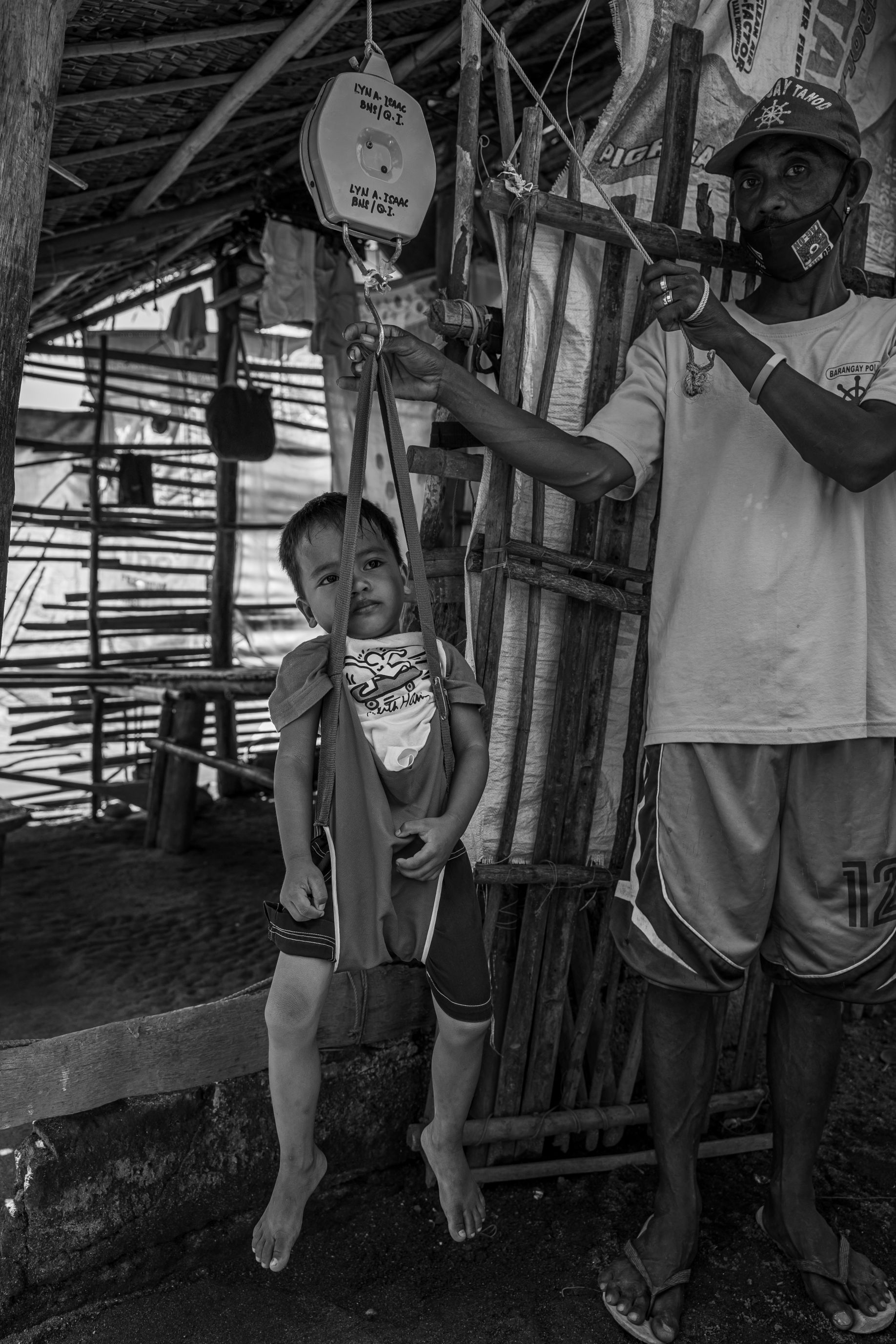
A child in Camarines Norte is weighed for the town nutritionist.
Late last year, a multisectoral effort was launched to address the root causes of involuntary hunger in the Philippines. Pilipinas Kontra Gutom (PKG) is the coming together of the government and private sector, and boasts the participation of some 70 outfits from non-government organizations, civil society groups, and private corporations. Their target is one million fewer hungry Filipinos by 2022. But the ultimate objective is more ambitious: eradicating hunger by 2030.
Zero Hunger by 2030 is one of the 17 Sustainable Development Goals of the United Nations, a set of universal goals set in 2012 that would help combat the urgent environmental, political and economic challenges of our times. The world is currently not on track to achieve this target. According to the United Nations, after decades of steady decline, the number of people who suffer from hunger globally began to slowly increase again in 2015. Before the pandemic, an estimated 135 million suffer from acute hunger around the world. The UN says COVID-19 has likely doubled that number — an additional 130 million people in 2020.
The same is certainly true in the Philippines, but administration officials believe there is reason to be hopeful. Cabinet Secretary Karlo Nograles chairs the government’s Task Force Zero Hunger (TFZH) which spearheads PKG. Nograles said that there simply hasn’t been a big, coordinated effort to address hunger before. PKG aims to brings together groups that have been implementing their own programs to combat hunger, a sort of coalition of the willing. Among its partners are Rise Against Hunger and Agrea.
PKG has four main strategies or work streams. First is farmer assistance, aiming to boost the income of farmers by 20 percent within the year, and double productivity by 2025. Second, sustainable nutrition programs to eliminate undernutrition among Filipino children across all households. Third, improved private sector disaster response during times of crises. And fourth, food banking to collect food surplus and distribute them to those in need.
TFZH has created a National Food Plan that Nograles says may serve as a playbook for administrations beyond 2022. Government also plans to continue, and possibly expand its current feeding programs under the Department of Social Welfare and Development, and the Department of Education.
“When you look at the problem of hunger you may get overwhelmed and think we can’t do it. But if you divide it into several key result areas, you may say, I think this is possible,” Nograles said.
Sonny Africa, the Ibon Foundation executive, thinks this is all hot air. For him, the government should prove its sincerity by providing immediate and adequate relief during the crisis. In other words, just put money into people’s hands.
Africa said addressing hunger, especially during the pandemic, is a matter of priorities. Ibon Foundation is advocating for a one-time cash assistance of PHP10,000 (USD208.99) per family as an immediate remedy. Africa insisted that government has enough money for this. In particular, he zoomed in on the administration’s flagship “Build, Build, Build” infrastructure program, which was allocated PHP1.3 trillion (USD27.17 billion) this year, as a possible source of funding.
“During the pandemic, do you need those fancy infrastructure projects, or should you help Filipinos who are hungry?” Africa asked. While programs that involve the private sector and civil society read well, IBON underscored the need to address the most pressing problems.
“In the end, you put your money where your mouth is. If you’re not giving a budget for these things, it’s all hot air.”
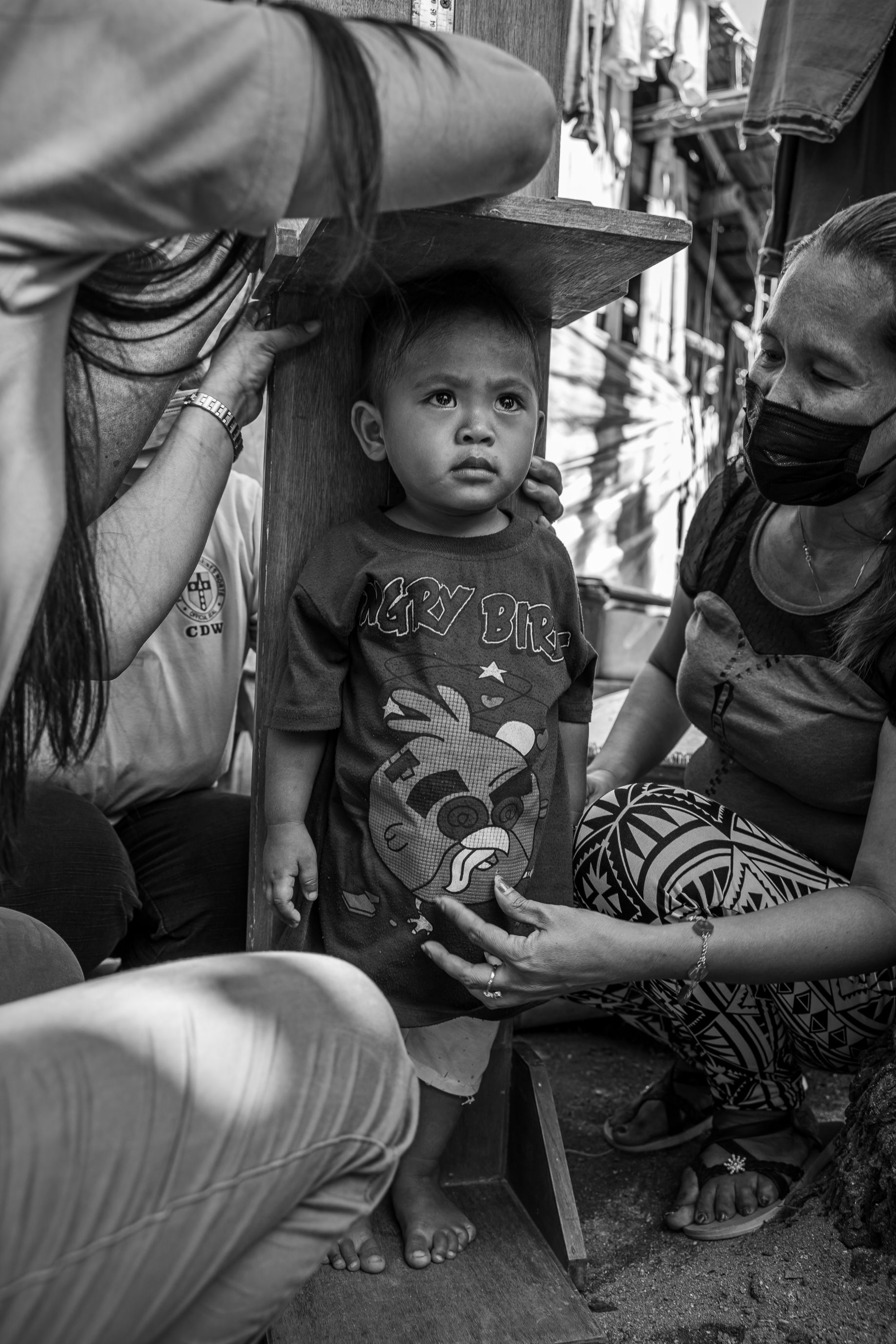
A child in Camarines Norte is measured for his height.
There is a prevailing assumption that the fight against hunger is something everyone can rally behind. But the controversy over community pantries shows that it is not that simple.
It’s difficult to watch long lines of people and not see it as evidence of desperation, and of people compelled to take matters into their own hands. To critics of the government, it exposed the shortcomings of the administration’s response to the pandemic. To supporters, it was an attempt to humiliate the government and undermine its efforts.
“The massive immiseration and the humongous mismanagement of the COVID-19 crisis has contributed to one of the steepest economic recessions anywhere in the world. So clearly you cannot separate the aspects of politics from the bigger picture, they’re very much intertwined,” political analyst Richard Heydarian said.
Hunger and chronic malnutrition cannot be understood, let alone eradicated, without considering the realities of power. People with the least social, economic, or political power are typically those who suffer from hunger and malnutrition. It is also power that dictates policy and action: where money is spent, which responses are promoted, and even who is allowed to help.
Heydarian reasserts that inequality is what has driven the problem of hunger in the Philippines from the beginning, and the problem is only getting worse because of the pandemic.
“Even prior to the pandemic, the Philippines consistently suffered from what economists call lack of inclusive growth,” Heydarian said. “In 2012, the 40 richest families in the Philippines took home 76 percent of newly-created growth. That’s one of the highest growth concentrations on earth. Since then, things haven’t really changed. Now combine that with a very unequal political system, where the majority of elected officials come from political dynasties, one can see that the Philippines is a very unequal society.”
Hunger and malnutrition are issues that will stick around long after the COVID-19 pandemic is vanquished. Addressing it will require focus, cooperation, and political will to align goals, policies, and existing resources. Perhaps it will also require a new way of thinking.
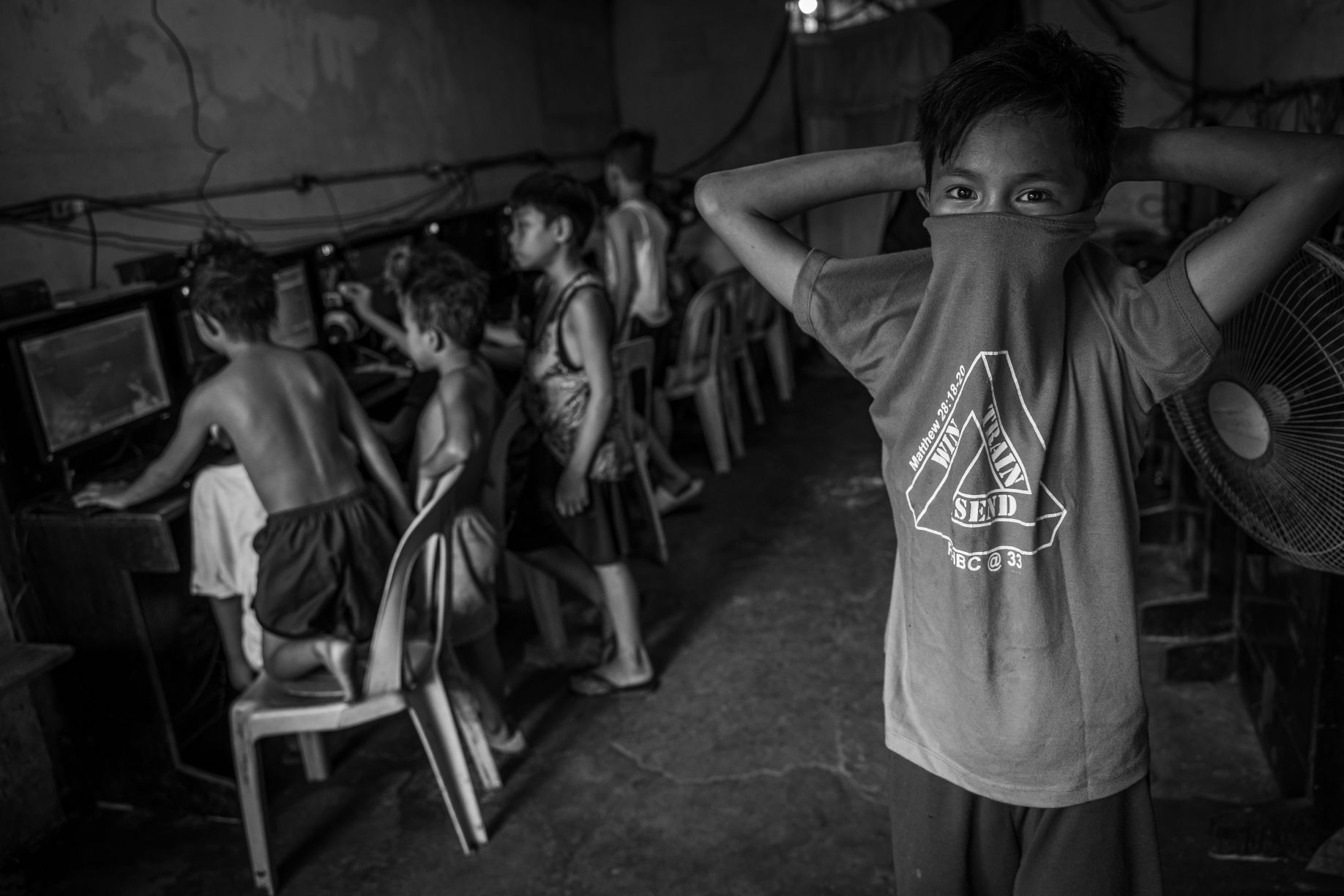
The problem of hunger and chronic malnutrition affects children the hardest — pandemic or no pandemic.
Back in Quinapaguian, the last streaks of daylight retreated behind faraway hills on a day like any other, bathing the island in warm, shifting colors for a few fleeting minutes. Jovito Mañago, the fisherman, and his family gathered around their rickety table to share a pitcher of instant coffee.
The youngest of the brood, Maricel, who was only 5 years old, held her mug with both hands, blowing into her drink to cool it down before taking a sip. This was dinner for tonight.
Jovito looked at his children before speaking.
“Maybe we just need support now. But I know many others are in need. I don’t ask for much. I just need a decent living. We’ll make it work somehow.”
In-depth special reports and features showcasing the best multimedia storytelling from GMA Integrated News.